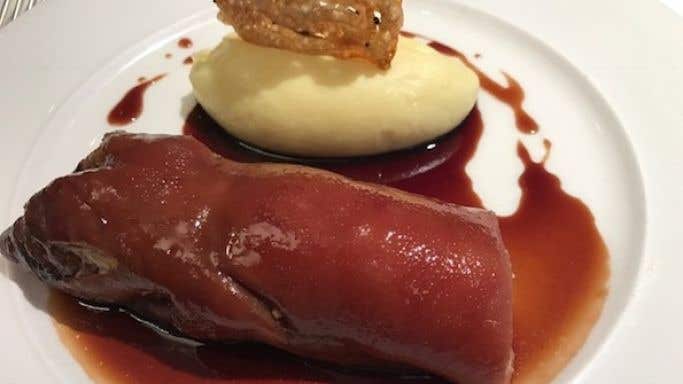At Koffmann’s restaurant in the Berkeley Hotel in London I was shown to what many people would describe as ‘the worst table in the whole place’.
It was a table for two just to the right of the entrance hall and on the uppermost of the three floors that make this space one of the most taxing for any inspired chef – and certainly one of the most tiring for its waiting staff.
When my guest arrived, she immediately apologised, explaining that she had used Bookatable, a division of Michelin that works under the hardly revolutionary slogan of ‘book now, pay when you dine’ to book our table. She used this website because of the deals they offer and with a number of hungry nieces to feed, she finds it makes her life somewhat cheaper.
But this table could not have been better for someone like me. It is known as table K5 in case there is anybody out there who shares my interest in restaurants. This table offers not just a glimpse of everyone coming in (I spotted Silvano Giraldin, ex MD of Le Gavroche, walking in with his wife) but also affords a great sense of anticipation: you can sit there and watch the waiters walk the long walk from the kitchen carrying the plates of food to their waiting tables.
This perch in restaurant Siberia did not stop me being noticed and no sooner had my guest sat down than we were offered a glass of Laurent-Perrier champagne with the compliments of Chef Koffmann. The afternoon was shaping up quite nicely.
We were handed the large menus although it was really only a question of choosing our starters. Since 1977 when a then young Pierre Koffmann opened the original La Tante Claire in Royal Hospital Road, Chelsea, his name has been synonymous with one dish, here referred to as ‘pied de cochon Tante Claire’. A glorious arrangement of culinary intricacy, the comfort of the excellent mashed potato and the gelatinous nature of the meat combined with its stuffing, Koffmann’s version remains supreme despite the number of young chefs whom he has taught over his now 50 years in a professional kitchen. And the news that Koffmann will close at the end of this year, taking his recipe with him, was why we chose to eat here.

From a concise list of fairly rich starters, we ordered two classic dishes. There was the lobster bisque shown above for me, poured from a jug on to a bowl containing two tortellini of lobster, plus another Koffmann classic ‘calamars Bolognaise’ helpfully translated on the menu as squid Bolognese style. This creation, whereby strips of frozen squid are cut into thin pieces and then cooked to order before being topped with some more gently cooked, and slightly spicier, squid was probably the better first course for what was to follow.
Because what did follow was undeniably rich and heavy. But it was also absolutely delicious.
Two round white plates arrived, each bearing four constituent parts: the reconstituted pig’s trotter shown above right, now full of diced sweetbreads and morels, but looking very much like the real thing; next to that was a small mound of mashed potato topped with a circular, crisp piece of pork crackling, and the whole was neatly surrounded by a luscious brown sauce. The bright green of the petit pois I ordered as a side dish added the only other colour.
The problem for anyone really intent on enjoying this dish is that it is virtually impossible to eat it slowly. All the textures are soft. These ingredients have been brought together by a chef who understands how dishes must be composed of no more than three, or maximum four, different constituent parts. And in this particular dish each ingredient is relatively easy to chew. That is, of course, apart from the small knuckle bones which are the ultimate barrier to anyone wiping his, or her, plate clean.
We felt defeated when the waitress brought the dessert menu (although Koffmann’s version of oeufs à la neige is one of the best) and somewhat reluctantly settled for coffee. I paid my bill of £117 and, as we were leaving, asked the manageress whether M Koffmann was in the kitchen. I wanted to take my guest in to say thank you in person.
A long walk past the bar and two other levels of restaurant ensued before we got to the kitchen. Right by the entrance, just to the left of where two young chefs were most competently running the pass, was a young Asian female chef with her back to us, her eyes firmly focused on her job in hand. As we walked in she turned round, smiled and revealed what she was doing. In front of her were raw pork trotters waiting to be stuffed with the special mixture of sweetbreads and morels. Mis en place is the kitchen term for what she was doing – in other words, getting the raw ingredients ready for a busy dinner service.
Pierre Koffmann was doing the same, dressed in his chef’s whites as he so often is, and working away in a far corner of the kitchen. I introduced my friend, we complimented him on the quality of all that we had eaten and the manner in which we had been served, and spoke for a few minutes. Then it occurred to me that this gentle Frenchman really wanted to get back to work and it was time to say goodbye. Which we promptly did, each of us shaking his enormous hand.
As I mentioned, this restaurant will close at the end of 2016, limiting opportunities for lovers of Koffmann’s very special ‘pied de cochon Tante Claire’. I am extremely glad that I made the trip.
Koffmann’s The Berkeley Hotel, Wilton Place, London SW1X 7RL; tel +44 20 7235 6000

